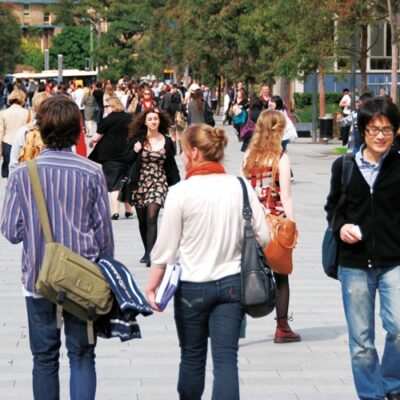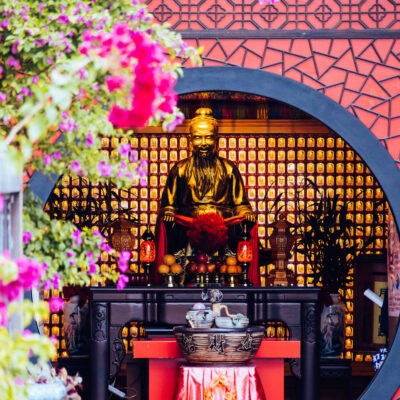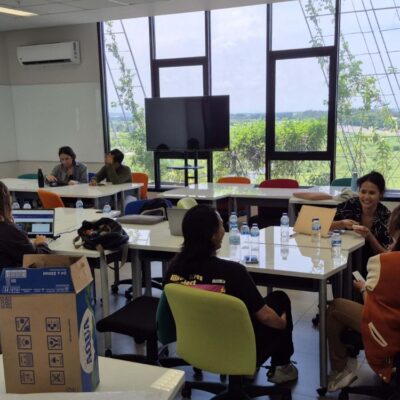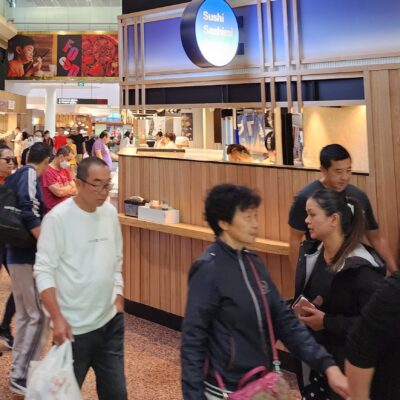Australia implemented unprecedented counter-terrorism measures of mass monitoring and preventative pre-crime offences following the hyper-securitisation of young Muslims after the events of 9/11. This was part of a broader turn in the West towards ‘militant democratic’ responses to violent Islamist extremism. Evaluations of the Australian response found it to be ineffective and counter-productive, effectively stigmatising Muslims as terrorist-producing communities.
Nationalistic anxieties, perceptions of threat, and extreme measures of reactionary law and order in Australia, however, are not recent turns. Scholar Ghassan Hage makes clear that nationalistic anxiety and ‘extreme’ measures of law and order are symbiotic to enduring White nation fantasies of Australia and its paranoid obsession with border politics. He argues that Australia is ‘structured around a White culture, where Aboriginal people and non-white “ethnics” are merely national objects to be moved or removed according to a White national will’. Through these lenses, the reproduction of threat and extreme policing powers is ‘old wine in new bottles’. Indigenous Australians, Muslim and ‘other others’ have all been constructed, at different times and in different ways, as threats to the established political stability of national identity and the nation.
We historicise militant democracy in the Australian context through a lens offered by the threat of Indigenous and Muslim peoples prior to 9/11. The concept of militant democracy centres on the notion that democracy is not only a political system but also a set of fundamental values that must be safeguarded. When applied, militant democracy intentionally restricts ‘certain democratic freedoms’ of so-named ‘malicious’ groups. The intent of militant democratic approaches is to defend public order and suppress violent extremism, by leveraging an array of legal, political, judicial, and para-military strategies, such as the use of force and surveillance. Scholar David Tittensor and colleagues’ foregrounding of post-9/11 militant democratic techniques helps us to understand contemporary Muslim-Australian political relations.
This present militant democracy does not exist in isolation—it has a long history in Australia. The policing of perceived ‘radical Islam’ extends a long held ‘colonial paranoia’. That is the idea of the perceived threat of ‘other’ bodies that threatens the White Australian national imaginary.
Securitising the ‘threat’ of the ‘colonised other’
Scholar Stuart Hall, in his seminal work on the moral panic associated with black muggings in the UK, identified that social reactions to perceived threats often have a long-ignored pre-history. He argues that perceived threats are phenomena usually ‘cut adrift from social roots’, and are ‘located in institutional structures’, often ‘far away from the scene of the crime’. When examining the historical basis of militant democracy in Australia we must understand how perceived threats to the national interest are determined and through what measures they are neutralized or rendered ‘safe’.
In the field of security studies, the concept of securitisation—a speech act—reveals the processes through which a specific issue, moment, or people are presented as an existential danger to the national interest. Securitising is a method of attaining ‘security’ by persuading the public and administrators that a ‘problem’ demands extraordinary and immediate action. In the act of securitising, the so-named threat is pushed from the boundaries of normal politics, often violating individual rights or legal protections enshrined within the ‘threatened’ state (i.e., militant democracy). The danger of securitisation for marginalised groups is that so-named threats and necessary solutions are socially constructed, subjective and fluid.
Central to the discourse of ‘security’ is the socially constructed (and also fluid) categorisation of race. In the context of our discussion, Australia has a complex history in which colonialism, race and security are intertwined. The underbelly of the modern world system is colonisation. Although a fluid system, it is built upon established racialised hierarchies and the threat of the colonised ‘other’. Moreton-Robinson argues that through racialisation, ‘whiteness operates possessively, to define and construct itself as the pinnacle of its own racial hierarchy’. According to scholar Aileen Moreton-Robinson, politically informed regimes of ‘truth’, establish and safeguard White patriarchal sovereignty—the dominant social and political system in Australia—which constructs Indigenous threats and problems to be solved by colonisers, so to justify continued control over Indigenous lands and peoples. Indigenous peoples were historically racialised as lacking civilisation and therefore in perpetual need of either eradication, saving or assimilation as political mechanisms used to safeguard control of seized Indigenous territories.
Coinciding with the move towards Federation, a congealing sense of nationalism and enduring anxieties associated with safeguarding Australia as a British White possession were continually accompanied by techniques of militant democracy (e.g., policies, laws, policing, media). Importantly, through similar techniques employed against Indigenous peoples, Muslim migrants and ‘other others’ such as refugees from non-white backgrounds were also racialised, so that their very presence became threats to the cultural, spiritual, and racial purity of the nation. Edward Said, a Palestinian-American scholar, coined the term ‘Orientalism’ to characterise how Western societies have discursively constructed and represented the Middle East, North Africa, and Asia. In Said’s view, the East has been constructed via a series of preconceptions and assumptions to be irrational, exotic, and a threat to the West. ‘Orientalism’, then as a discourse functions to justify colonialism, military intervention, and cultural imperialism.
The relationships between the constructed threat of the colonised ‘other’, techniques of racialisation and fluid states of security, are deeply ingrained in Western thought and the function of its institutions. When viewed through the lens of historicised racialised fears proximal to techniques of militant democracy, Western thought and its institutions seem to operate to validate the invasion, theft and possession of territories for sustained profit.
Historicising the threat of the ‘Indigenous ‘other’ & ‘other others’
The original and enduring fear of White Australia, and subject of its many techniques of militant democracy, is the threat of organised and sustained Indigenous resistance to the theft of land and dehumanisation of peoples.
Australia was colonised by the British through invasion in the late 18th century by invoking the legal fiction of terra nullius, or unoccupied land. Ensuing settler-colonialism enacted a system of structural violence, in which the settler population continues to benefit from the dispossession, exploitation and oppression of Indigenous peoples and lands. Throughout the enduring encroachment of settler-colonialism, Indigenous peoples have maintained persistent acts of resistance, including armed conflict, sabotage, and political agitation. Armed resistance, graphically recounted in the work of historian Henry Reynolds and the SBS series, The Australian Wars, was widespread and caused great anxiety over the safety and stability of early colonies and the subsequent expansion of frontier settlements. Persistent actions such as these led to extreme measures of systematic dispersals of Indigenous families from frontier lands, such as the Myall Creek massacre (c.f. map of colonial frontier massacres). Specifically in Queensland, the institution of the Native Mounted Police—a barbarous militia of armed Aboriginal troopers under the orders of White officers—was employed to clear frontier spaces and ensure safety for settlers working stolen lands. Research on the Queensland Native Mounted Police notes that in performing the dispersals of frontier lands, armed regiments travelled without mobile jails—the implication being to clear the land and take no prisoners. Aboriginal bodies were often burned to cover up the killings.
As colonisation progressed, genocidal practices compounded by the theft of ancestral lands and exploitation with opium and alcohol to elicit a docile Indigenous workforce and sexual servitude, eventually led away from moral panics associated with the imminent threat of violent resistance, toward long-term anxieties over maintaining the racial purity of White Australia. During the 19th century in frontier Australia, the ‘threat’ of interbreeding and the creation of mixed blood offspring was particularly strong in areas where White settlers and Indigenous peoples came into contact. At the heart of these fears were pseudo-scientific ideas of social Darwinism, where fluid and subjective techniques of racialisation, rendered Indigenous peoples as uncivilised, primitive, and unfit for the modern, White world. These ideas also coincided with the inaccurate and disproven ‘scientific’ belief that certain races are inherently superior and should be preserved through selective breeding; and that mixing of races would lead to a degeneration of Australia. Purity of the White race was deemed vital so to safeguard Australia as a White possession.
Moral panic throughout Australia’s colonies and expanding frontiers, tied to the pseudo-scientific ideas of social Darwinism and eugenics, led to the construction of the ‘smooth the dying pillow’ discourse as the next technique of militant democracy. This discourse was based upon White guilt—acutely aware of the impact colonisation had on the traditional Aborigine—which prompted a responsibility as the superior, civilised race to ‘protect’ the once ‘noble savage’ as it succumbs, as the weaker, ‘unfit’ race, to the ceaseless advance of modernity. The ideology of ‘protecting’ the Aborigine from themselves and the White race, was used to justify government sanctioned policies and practices of Indigenous segregation on government reserves and Christian-administered missions. Officially operating throughout the late 19th and early 20th centuries, policies of Protection legislated the forced removal of Indigenous peoples from traditional territories and imprisonment on isolated parcels of land, strategically distanced from White towns, segregated from White populations. Life on reserves and missions was overtly draconian, where Indigenous peoples were trained in European-style farming and domestic work practices, forced to work long hours for little pay (c.f. stolen wages class action) and were subject to sustained indoctrination in White Christian values and customs. Protection policies suppressed Indigenous cultural practices, subjected peoples to mass surveillance and controlled the movement of people via strict regulations that determined employment, education, and social interactions, such as the ability to marry, and to whom. Assimilation policies operated in parallel to protectionist techniques and were based on the belief that ‘half-caste’ (and other terms such as ‘quadroon’ were also used) Indigenous children should be protected from their ‘full blood’ families and assimilated into White Australian society (see: Stolen Generations.)
While Indigenous reserves and missions operated in remote parts of Australia, purposefully located to distance Indigenous peoples from the White race, deliberate practices of segregation also operated in many cities and towns. Throughout the 19th and early 20th centuries, the operation of ‘boundary streets’ demarcated a physical and social divide between White and non-white populations. Scholars Kelly Greenop and Paul Memmott discuss the function of boundary streets in Brisbane, and explain the perceived threats of Indigenous peoples:
…the exclusion of the Indigenous population at night was designed to prevent night raids by Aborigines on homes and gardens (as food sources) and to keep Aboriginal ceremonial activity, which was considered indecent behaviour, out of the view of the settlers. Lentz, a boy in South Brisbane in the 1870s, recalls that: “After 4pm the mounted troopers used to ride about cracking stockwhips to notify the Aboriginals to get out. They were allowed in town by day, but not after sundown”.
Boundary streets were located on the outskirts of urban areas and functioned as the marker of zones reserved for White Australians and Aboriginal peoples and at times other non-white peoples. Non-white areas were typically overcrowded, with poor housing conditions and limited access to public services and amenities, while White areas were more affluent and better resourced. Boundary streets continued to exist in Australian cities until the mid-20th century.
Despite the persistence of techniques of securitisation and militant democracy operating in tandem, the political struggle for land rights gained momentum in the 1960s and 70s. Land rights centred upon the demand to recognise traditional ownership of the land, and the parallel right for Indigenous self-determination and cultural autonomy. The passing of the Mabo verdict (1992) by the High Court of Australia, which overturned the legal fiction of ‘terra nullius’ (land owned by no-one), received a mixed response from broader Australia. Some sections of Australian politics, private enterprise and mass media reacted with panic and alarm, framing Mabo as a threat to national unity and the Australian way of life. Combined political, corporate and media moral panic over the Mabo decision was fuelled by a fear of loss of control over Indigenous land and resources. The High Court ruling was constructed by many as a threat to national interests and a radical departure from established legal precedent. The Mabo decision tapped into the enduring White paranoia over the mobilisation of a coordinated Indigenous resistance and that legally non-Indigenous people would have reduced land rights (the commonly expressed concern that their backyards would be taken away). Indigenous land rights threaten the White Australia imaginary, while also raising fear about financial compensation for the deliberate dispossession of Indigenous peoples and greater control over Australia’s resources.
As recently as June 2007, techniques of militant democracy were enacted against Aboriginal peoples in the Northern Territory (NT). The Federal Government declared a ‘national emergency’ in the form of the Northern Territory Emergency Response. The military were deployed into NT Aboriginal communities under the guise of protecting Aboriginal children from widespread allegations of sexual abuse and seized control of some Aboriginal communities. In this so-called national emergency, the federal government said it was acting on a NT government commissioned report, Little Children are Sacred. The forced used of military power was enabled by suspending the Racial Discrimination Act to allow Government to seize control in the name of ‘intervention’.
Historicising the threat of the Muslim other and ‘other others’ in Australia
During the 19th and early 20th centuries when Indigenous peoples were being killed, imprisoned, ‘protected’ and assimilated as part of the colonial project, Muslim Afghan cameleers and Indian hawkers were a common sight in rural and regional areas. Despite forming a significant part of the workforce vital to the nation, their presence was met with resistance and hostility from White Australians, who perceived them as a threat to their livelihoods and to the racial and cultural purity of White Australia.
In the 1890s in western Queensland and north-western New South Wales there was a major campaign of racist vilification against the cameleers and hawkers. The perceived threat of non-white immigrants fed into White Australia’s broader anxieties over the social, cultural, and racial fabric of the national identity. An article in The Illustrated Australian News – accused ‘Afghan’ hawkers of bullying women in outlying farming districts whose husbands were away into buying their products. The ‘Afghans’ were declared as ‘more detestable than the Chinese’ by local newspapers and were also attacked for refusing to drink alcohol and for opening their own stores and butcher shops. These stereotypes were reinforced by media reports and racist and xenophobic stereotypes, which portrayed Muslim men as hypersexual, deviant, unhygienic, and dangerous. In 1896, a Sydney Morning Herald article (14th Jan) on the question of renewal of the Syrian-Indian hawkers licences in the Redfern area of Sydney it is written:
Many of those men when hawking their goods are importunate in the extreme degree, and as they visit, during the absence of the husband, isolated homes, their pertinacity is not merely embarrassing to the women and children, but most annoying. In regard to some of them pertinacity is not their only fault. From time to time complaints have been made publicly to the effect that some of these hawkers were a great nuisance, as they went about the country terrifying women and children.
As a result of these fears of perceived threats, there were attempts to limit the interactions between Muslim cameleers, hawkers and White Australian women. For example, in 1896, the South Australian government passed the ‘Camel Driver’s Act’, which required Muslim cameleers to obtain a license before entering towns and cities, and prohibited them from owning or riding horses, which limited their ability to interact with the wider community.
It is telling that in 1901 the Commonwealth of Australia was ‘inaugurated in an act of racial expulsion’ with a package of legislations enacted by the new parliament that marked out the racial boundaries of the new nation. This included the Pacific Island Labourers Act 1901 (Cth) (No. 16 of 1901) on 17 December 1901: ‘An Act to provide for the Regulation, Restriction, and Prohibition of the Introduction of Labourers from the Pacific Islands and for other purposes’. The Act was designed to expel the thousands of Pacific Islanders—colloquially and demeaningly known as ‘Kanakas’, who had been brought to Queensland under indentured labour agreements to work in the sugar cane fields—and to halt further recruitment. This act of racial expulsion was extended to all Asians through further legislation with the Immigration Restriction Act 1901 (Cth) (No. 17 of 1901) passed on 23 December 1901 (commonly known as the White Australia policy). Under this Act, new migrants had to sit a 50-word dictation test. The aim of the law was to limit non-white (particularly Asian) immigration to Australia, to help keep Australia ‘White/British’. Attorney-General of Australia at the time, Alfred Deakin was to comment in 1901 (12th September) in reference to the impact of the dictation test as a preventative technique,
‘That end, put in plain and unequivocal terms … means the prohibition of all alien-coloured immigration, and more, it means at the earliest time, by reasonable and just means, the deportation or reduction of the number of aliens now in our midst. The two things go hand in hand, and are the necessary complement of a single policy—the policy of securing a “white Australia”.’
Deakin’s vision of the function and success of the dictation test was proved with only 52 people having passed the test between 1901 and 1909 (from 1,359 tests) and no one passed after 1909. The Immigration Restriction Act 1901 was not definitively renounced until 1973 by the Labor government led by Prime Minister Gough Whitlam.
Then Social Editor of The Barrier Truth in Broken Hill, R.S. Ross, wrote an article on ‘The Afghan Menace’ (1903), attributing everything from sexual depravity to brutality and gross superstition to these people who were ‘by breed and nature a bird of prey’. Ross claimed the Afghans were a ‘danger to the town’s morals’ and that they along with the Chinese were ‘inferior alien labourers’ and should not be in Australia because they were untrustworthy ‘coloured mongrels’ that ‘tend always to sterility and extinction’. Ross declared that banning their entry was a ‘fundamental instinct to protect the [White] species’. Despite these efforts to limit interactions, there is little evidence to suggest that interbreeding between Muslim cameleers and White Australian women, or a reduction of commercial opportunities for non-Muslims, as a significant issue, or a threat to the nation. Nevertheless, the thoughts of those like Ross were common, which in turn led to racist preventative policies, and instances of assaults, murder or ‘suicide’. In 1913, the Queensland government compiled a register, Coloured Labour and Asiatic in Queensland 1913, capturing the names of non-British subjects who lived in various Queensland Police Districts in Queensland at the time to surveil non-white bodies.
After more than 60 years of White only immigration to Australia, the 1970s and 80s led to a significant influx of Vietnamese and Lebanese immigrants fleeing conflict in their home countries. However, this was met with mixed reactions from the Australian public, concerned that the newcomers would take local jobs, lower wages, and strain social services and infrastructure. Additionally, there were concerns about cultural differences and the potential for cultural clashes between immigrants and the wider Australian community. Notwithstanding early fears of Asian drug and sex trafficking and Indo-Chinese triads, overall, the Vietnamese were mostly seen as a hardworking and of little threat to White Australians. However, the Lebanese were seen otherwise.
In the late 1990s, there were several high-profile incidents involving alleged ‘Lebanese’ crime gangs, including the murder of Edward Lee, a 14-year-old boy of Korean descent, in the Western Sydney suburb of Punchbowl, and the drive-by shooting of the Lakemba Police Station in Sydney in 1998. Occurring before the 9/11 attacks on the USA in 2001, the confluence of these two events led to a media driven collective White moral panic over the threat of Middle Eastern gangs and those of ‘Middle Eastern’ appearance. There was mainstream media speculation that the police shooting was community-led retaliation for the extreme ‘stop and search’ measures in the Bankstown district of Sydney orchestrated by 130 police, including mounted police and dog squads. These ‘pre-crime’ measures netted 24 arrests and 74 charges in one day. In an 18-month period following these events, a moral panic over the threat of ethnic crime, youth gangs, and those of ‘Middle Eastern’ appearance, were consistently reported in the media, hotly debated as a key federal election issue, and led to New South Wales emergency police powers and strict law and order crackdowns in populous Lebanese suburbs. Western States’ use of border control technologies from the twenty-first century is another example of contemporary continuations of extreme measures to regulate the risk of the securitized undesirable ‘other’. Unsurprisingly, Australia in 1992 institutionalised asylum detention and introduced offshore immigration detention with the federal government’s so-called Pacific Solution in 2001.
Interestingly, despite this escalation occurring prior to 9/11, and although the focus centred upon the threat of the ‘ethnic other’, rather than religion (i.e. ‘radical Islam’). The public debate over security and policing ushered in tougher new laws which gave police and the courts more power to deal with the constructed threat of ‘ethnic’ crime. Islamophobia refers to the unfounded fear and hostility directed at Islam or Muslims driven by racism at the local, state, and international levels, though often concealed by the assertion that Islamophobia is not racism because Islam is a religion and not a race. However, while such anti-Islam/anti-Muslim sentiments continue to be prevalent among Australians, governments may be slow to adopt alternatives to securitising policies and programs, even those found to be ineffective and counter-productive.
Muslim Australians overwhelmingly reject violent extremism. The post-9/11 violence perpetrated by Muslims is not an expression of an inherent hatred in Islam of non-Muslims but is related to socio-political time-period factors. There is a well-established Islamic tradition of peacemaking through covenants and treaties with non-Muslims enshrined in the Qur’an and the diplomacy of Muhammad, the prophet of Islam. The under-recognised consequence of securitisation policies that arise in the context of a militant democracy, is that the views of society and the State concerning the racial and religious ‘other’ tend to perpetuate insecurities.
Conclusion
The discursive construction and policing of perceived Indigenous and Muslim threats and problems have been an enduring feature of the Australian political order. The presence of an internally based Indigenous sovereignty will always remain an enduring threat to the national identity and nation, with its need to dispossess the logic of the White claim to both soil and identity. Likewise, the exotic threat of the colonised ‘other’, and the continuing expansion of the Islamic faith will continue to threaten White nation fantasies of Australia and its paranoia over border politics which have a strong and enduring historical basis. Intergenerational reproduction by White cultural institutions (i.e., parliaments, mass media and law and order) sustains systemic racism, and the perpetuation of racial stereotypes that have negatively impacted the lives of Indigenous and other non-white peoples in Australia. Techniques of militant democracy geared toward the ‘colonised other’ will continue to limit opportunities to grow coordinated and harmonious societies, forgoing the opportunity to build upon the strengths and contributions of all peoples.
Authors: Dr Troy Meston, Associate Professor Debbie Bargallie and Professor Halim Rane.
Troy Meston is a Gamilleroi Indigenous Australian Muslim. He is a Senior Research Fellow in the Centre for Social and Cultural Research at Griffith University, Queensland.
Debbie Bargallie is a Kamilaroi and Wonnarua Indigenous Australian Muslim. She is an Associate Professor in the Centre for Social and Cultural Research and the Institute for Educational Research at Griffith University, Queensland.
Halim Rane is a Professor of Islamic Studies at Griffith University, Queensland.
Image: Invasion Day rally in Melbourne, 2019. Credit: Matt Hrkac/Flickr.




